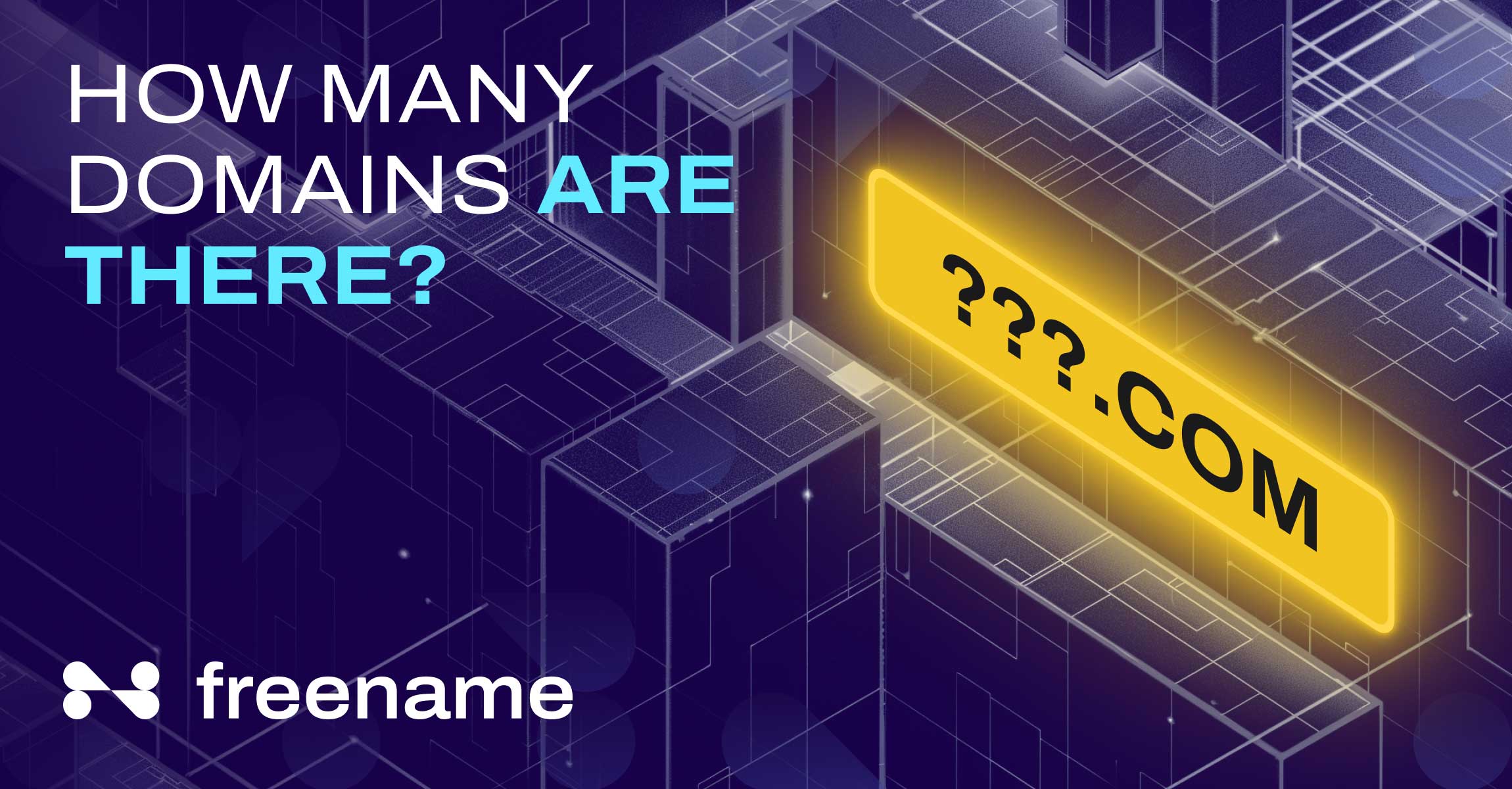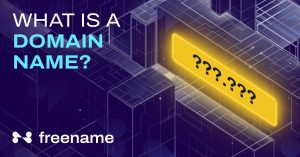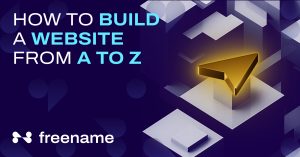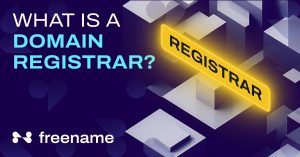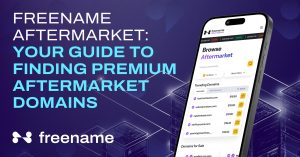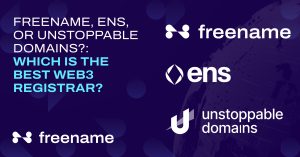The internet without domain names would be super confusing. Every website would have a long string of numbers. Try imagining memorizing phone numbers for every business and contact you know. But gone is the era of phonebooks because now domain names serve as the internet’s directory. With a Domain Name System, it’s easy to type in and access various websites.
Domains shape digital identities. They power communication, social media, and e-commerce. But with the internet expanding all the time, tracking the number of registered domains can give us a glimpse into its growth, trends, and demand for online real estate. Let’s explore how many domains are there on the internet and look at the statistics of domain registrations.
Total Number of Domains Registered Worldwide
How many domains exist currently? Based on the latest data available from Verisign’s quarterly report, there’s a total of 364.3 million registered domain names globally. Many of these domains belong to GoDaddy and Namecheap as, reportedly, the biggest registrars in the world.
However, the global domain name landscape comprises different categories. For example, how many top level domains are there? Check out the breakdown of domain registration by category below.
- Generic Top-Level Domains (gTLDs): gTLDs are the most common domain extensions—these include the ever-popular .com, .net, and .org. As of Q3 2024, .com and .net TLDs had a combined total of around 174.2 million registrations.
- Country-Code Top-Level Domains (ccTLDs): These are two letters specifically assigned for countries or territories like .uk (United Kingdom), .de (Germany, and .cn (China). These domains collectively account for a major portion of global domain registrations. Access ICANN’s Domain Name Marketplace for more info (registration required.)
- New Generic Top-Level Domains (new gTLDs): Ever encountered domains ending in .shop, .online, or .xyz? Those are new gTLDs introduced as part of ICANN’s expansion program. Around 36 million new gTLDs were added in 2024, which points to the healthy growth of these alternative domains.
- Web3 Domains: Web 3 domains (e.g., .crypto, .eth, and .dao) have begun to pop up. They’re associated with decentralized technologies and blockchain platforms. The exact registration number fluctuates, but the growth looks substantial.
Growth Trends in Domain Registrations
Consistent growth persists in the domain name industry. This reflects the ever-expanding digital landscape as many individual users and businesses seek to establish their online presence.
According to Verisign, the total number of registered domains across all TLDs has been steadily increasing. In 2024, Verisign’s revenue for the year is $1.56 billion, showing a 4.3% growth from the previous year. This indicates a robust industry where sustained growth exists in most places.
Other than businesses seeking expansion and recognizing the need for a strong online presence, other reasons for growth in domain registrations may be attributed to emerging technologies like artificial intelligence. The .ai domain, for example, has been profitable for Anguilla, a British Territory in the Caribbean, which registered the domain. The territory’s capitalization on this trend has amounted to a $32 million quadrupled registration fee.
Meanwhile, alternative DNS roots are supporting Web3 domains. Platforms like Handshake and Namecoin offer decentralized domain registration options. This reflects the shift towards a more secure and censorship-resistant internet.
Some trends that are currently happening in the world of domain names are:
- .com remains the most popular TLD.
- ccTLDs like .de, .cn, and .uk continue to be widely registered.
- Alternative TLDs like .tv (belonging to Tuvalu) and .me (Montenegro) are favored for personal branding.
- Furthermore, .app domains, introduced in 2018, have grown to 600,000 registrations by early 2023, indicating a strong interest in industry-specific TLDs.

How Many Domains Are Active vs. Parked?
Some domains are active, some are not. This is where you get an active domain vs. a parked domain. An active website is one whose domain name is ‘alive’—the website provides current content, available products, and active services to users. In contrast, a parked domain is a registered domain not linked to an active website. It goes instead to a landing page, often containing ads or info about the domain’s availability for sale.
Based on a 2023 scan, it was reported that around 17.5% of 334 million domains are parked. Newer numbers have not been reported. However, parked domains are a common practice among domain investors. They register domains with the intent to sell them at a profit or generate a passive income.
Future of Domain Registrations
Domain registrations may face further developments as Web2 starts to shift to Web3. While Web2 domains, governed by centralized authorities like ICANN, have traditionally dominated the internet, the appearance of Web3 domains holds great appeal.
Web3’s blockchain-based domains like .crypto and .eth offer users more control of their privacy, security, and data. They also tend to resist censorship as they stand outside the centralized authorities. This shift to Web3 marks the beginning of user empowerment where users have sovereignty over their digital identities without intermediaries.
Other developments in domain names are as follows:
- AI and blockchain integration: AI meeting blockchain is what’s expected to happen to democratize access to technology. Hopefully, this will lead to more secure and efficient domain management.
- TLDs diversification: The rise of industry-specific and creative TLDs, like the aforementioned .ai, .apps, and .tv, will continue to be popular among businesses.
How to Check Domain Availability?
Want to register a domain? Here’s a guide to help you secure the perfect domain.
- Go to a domain registrar. Any domain registrar of your choice will have the domain search tool. Enter your preferred domain name on the search bar and the website will tell you whether it’s available or taken.
- Check ICANN’s WHOIS Lookup. If the domain you want is registered, you can see details about the domain using this lookup tool.
- Explore domain marketplaces. If you still haven’t found a domain, explore the Freename domain aftermarket.
- Register the domain. After you find the domain of your choice, start the registration process with the registrar. Pay the registration fee and enjoy your new domain.
You can also be a player in the domain aftermarket. If you register a domain that has the potential to boom in popularity, you can buy the domain and market it to the domain aftermarket. As you know, the domain aftermarket is where domains are resold. It’s a way to generate passive income. Otherwise, you can enter the domain aftermarket to look for domain resellers or look for expired domains.
Conclusion
Domain registrations constantly evolve. We’ve explored how domain growth is influenced by business expansion, digital trends, and new technologies like blockchain and AI. Meanwhile, the domain aftermarket offers opportunities for getting premium names. The distinction between active and parked domains also highlights the market’s dynamics.
If you’re looking to secure a domain, check its availability now and invest wisely. Whether you register a new name or explore the aftermarket, strengthen your online presence with the right domain name today.

FAQ
How many domains are registered daily?
There are around 33,000 new domains registered on a daily basis.
Will we ever run out of domain names?
No, it’s unlikely we’ll ever run out of domain names because new TLDs are constantly being added, and expired domains may become available again.

